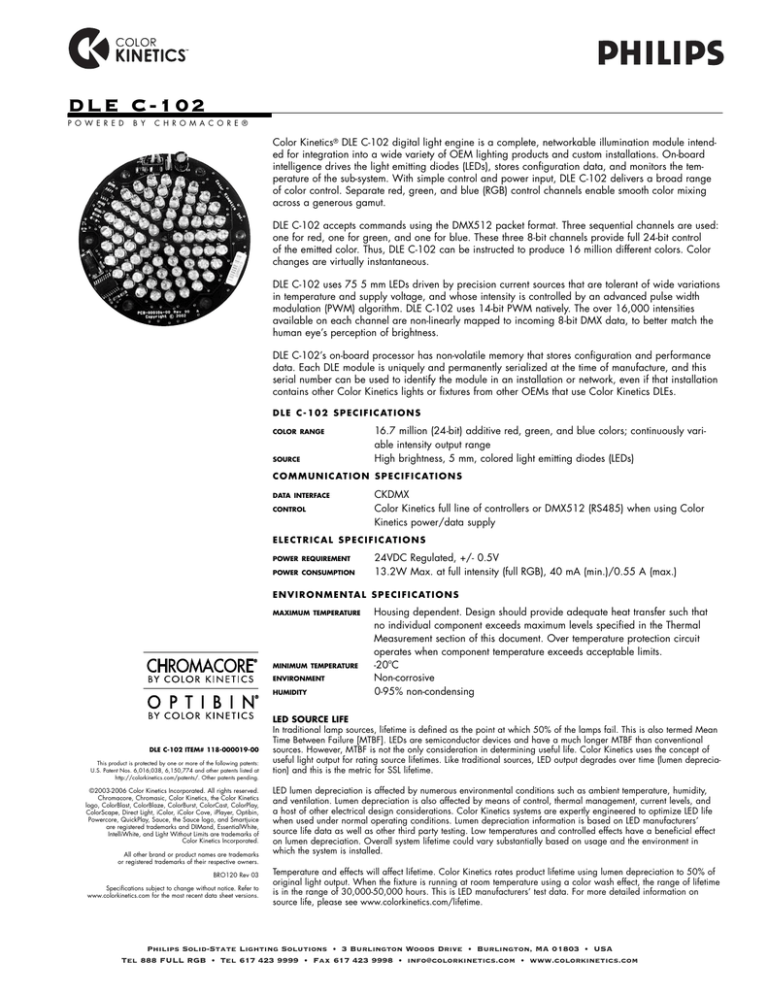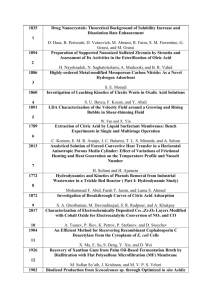
DLE C-1 0 2
P O W E R E D
B Y
C H R O M A C O R E ®
Color Kinetics® DLE C-102 digital light engine is a complete, networkable illumination module intended for integration into a wide variety of OEM lighting products and custom installations. On-board
intelligence drives the light emitting diodes (LEDs), stores configuration data, and monitors the temperature of the sub-system. With simple control and power input, DLE C-102 delivers a broad range
of color control. Separate red, green, and blue (RGB) control channels enable smooth color mixing
across a generous gamut.
DLE C-102 accepts commands using the DMX512 packet format. Three sequential channels are used:
one for red, one for green, and one for blue. These three 8-bit channels provide full 24-bit control
of the emitted color. Thus, DLE C-102 can be instructed to produce 16 million different colors. Color
changes are virtually instantaneous.
DLE C-102 uses 75 5 mm LEDs driven by precision current sources that are tolerant of wide variations
in temperature and supply voltage, and whose intensity is controlled by an advanced pulse width
modulation (PWM) algorithm. DLE C-102 uses 14-bit PWM natively. The over 16,000 intensities
available on each channel are non-linearly mapped to incoming 8-bit DMX data, to better match the
human eye’s perception of brightness.
DLE C-102’s on-board processor has non-volatile memory that stores configuration and performance
data. Each DLE module is uniquely and permanently serialized at the time of manufacture, and this
serial number can be used to identify the module in an installation or network, even if that installation
contains other Color Kinetics lights or fixtures from other OEMs that use Color Kinetics DLEs.
D L E C - 1 0 2 s p ec i f i c at i o n s
16.7 million (24-bit) additive red, green, and blue colors; continuously vari-
color range
source
able intensity output range
High brightness, 5 mm, colored light emitting diodes (LEDs)
C O M M U NI C ATION s p ec i f i c at i o n s
data interface
control
CKDMX
Color Kinetics full line of controllers or DMX512 (RS485) when using Color
Kinetics power/data supply
E L E C T R I C A L s p ec i f i c at i o n s
power requirement24VDC
power consumption
Regulated, +/- 0.5V
13.2W Max. at full intensity (full RGB), 40 mA (min.)/0.55 A (max.)
E n v i r o n me n ta l S p ec i f i c at i o n s
maximum temperature
minimum temperature
environment
humidity
DLE C-102 ITEM# 118-000019-00
This product is protected by one or more of the following patents:
U.S. Patent Nos. 6,016,038, 6,150,774 and other patents listed at
http://colorkinetics.com/patents/. Other patents pending.
©2003-2006 Color Kinetics Incorporated. All rights reserved.
Chromacore, Chromasic, Color Kinetics, the Color Kinetics
logo, ColorBlast, ColorBlaze, ColorBurst, ColorCast, ColorPlay,
ColorScape, Direct Light, iColor, iColor Cove, iPlayer, Optibin,
Powercore, QuickPlay, Sauce, the Sauce logo, and Smartjuice
are registered trademarks and DIMand, EssentialWhite,
IntelliWhite, and Light Without Limits are trademarks of
Color Kinetics Incorporated.
All other brand or product names are trademarks
or registered trademarks of their respective owners.
BRO120 Rev 03
Specifications subject to change without notice. Refer to
www.colorkinetics.com for the most recent data sheet versions.
Housing dependent. Design should provide adequate heat transfer such that
no individual component exceeds maximum levels specified in the Thermal
Measurement section of this document. Over temperature protection circuit
operates when component temperature exceeds acceptable limits.
-20ºC
Non-corrosive
0-95% non-condensing
LED Source Life
In traditional lamp sources, lifetime is defined as the point at which 50% of the lamps fail. This is also termed Mean
Time Between Failure [MTBF]. LEDs are semiconductor devices and have a much longer MTBF than conventional
sources. However, MTBF is not the only consideration in determining useful life. Color Kinetics uses the concept of
useful light output for rating source lifetimes. Like traditional sources, LED output degrades over time (lumen depreciation) and this is the metric for SSL lifetime.
LED lumen depreciation is affected by numerous environmental conditions such as ambient temperature, humidity,
and ventilation. Lumen depreciation is also affected by means of control, thermal management, current levels, and
a host of other electrical design considerations. Color Kinetics systems are expertly engineered to optimize LED life
when used under normal operating conditions. Lumen depreciation information is based on LED manufacturers’
source life data as well as other third party testing. Low temperatures and controlled effects have a beneficial effect
on lumen depreciation. Overall system lifetime could vary substantially based on usage and the environment in
which the system is installed.
Temperature and effects will affect lifetime. Color Kinetics rates product lifetime using lumen depreciation to 50% of
original light output. When the fixture is running at room temperature using a color wash effect, the range of lifetime
is in the range of 30,000-50,000 hours. This is LED manufacturers’ test data. For more detailed information on
source life, please see www.colorkinetics.com/lifetime.
Philips Solid-State Lighting Solutions • 3 Burlington Woods Drive • Burlington, MA 01803 • USA
Tel 888 FULL RGB • Tel 617 423 9999 • Fax 617 423 9998 • info@colorkinetics.com • www.colorkinetics.com
DLE C-102
photometric performance
The photometric data below is based on the following constraints: DLE C-102 is mounted into a 4-inch, round fixture with tempered soft focus glass diffuser. Refer to the ColorBurst® 4 datasheet for example.
Photometric data is based on test results from an independent testing lab.
source specifications
gamut
Optics: Tempered soft focus glass diffuser
Source:
755 mm LEDs (25 Red, 25 Green, 25 Blue)
Beam Angle:
33° (at 50% of peak illuminance)
0.8
Distribution:
Symmetric direct illumination
0.7
CCT:
Adjustable 1,000K–10,000K
CRI:
Not measurable (CIE 13.3-1995)
0.6
1.4
15.1
4.4
30.1
2.0
5.2
21.5
2.5
19.7
9.9
26.9
0.7
7.5
2.9
11.8
21.1
6.6
106.6
1.9
227.1
6.6
71.0
1.5’/0.5m
91.5
9.9
327.2
227.1
31.2
8.5
30.4
21.1
56.0
212.1
327.2
20.5
1.1
19.7
30.4
1.9
5.2
103.3
212.1
106.6
30.1
9.6
103.3
91.5
2.8
47.4
9.6
8.5
26.9
4.4
47.4
56.0
2.5
2.8
20.5
2.9
71.0
31.2
3.0’/1.0m
1.4
0.2
2.0
21.5
0.1
2.5
26.9
2.5
0.0
0.0
1.5’/0.5m
26.9
6’
1m
5.2
223.7
69.3
green
2.6
114.1
11.8
58.1
0.8
candle power distribution
0.0’/0.0m
-90
Measured on:
Beam center:
Thin dashed lined:
Multipliers:
2.8
12.7
color
94
140
187
90
White
197 cd
Indicates 50% of peak
0.31 Red, 0.51 Green, 0.26 Blue
(nm)
(lumens)
power
(watts)
na
89
10.2
620.5 - 631
27.6
3.4
8.1
green
520 - 535
45.4
3.4
13.4
blue
460 - 480
23.1
3.4
6.8
0.4
4.6
0.2
6.5
47
light output
8.9
7.7
0.6
14.5
0.7
5m
0.3
1.2
1.4
0.6
1.1
24.9
28.5
5.4
blue
0.4 0.5
x Axis
0
0.8
0.7
17.3
10.6
0.3
White point shown by diamond.
15’
2.3
1.6
0.2
7.5
3m
55.9
6.4
red
9’
2m
20.8
white
0.1
0.7
Footcandles/Lux
White
1.5’/0.5m (from bottom of grid with light at a 45º angle)
0.31 Red, 0.51 Green, 0.26 Blue
3’
0.4
0.3
15.1
Illuminance
color
0.5
1.5’/0.5m
0’/0m
Units:
Measured on:
Distance from surface:
Multipliers:
y Axis
illuminance distribution
CIE 1931 Standard Observer
0.9
2.3
white
red
wave length total output
efficacy
(lm/w)
8.72
Measured in Footcandles/Lux on axis.
OPTIBIN®
There are inherent variations in the fabrication processes of all semiconductor materials. For LEDs, this variance results in differences in the color and intensity of light output as
well as electrical characteristics. Due to these differences, LED manufacturers sort production into “bins,” but insuring the availability of a single bin is very difficult. To minimize
this issue and achieve optimal color consistency in its products, Color Kinetics has developed and uses a proprietary technology called Optibin. Optibin is an advanced production binning optimization process that minimizes the effects of LED variance for the best possible output uniformity in the final product. Color Kinetics Optibin technology gives
the most consistent control of color and intensity from product to product.
C
T
Philips Solid-State Lighting Solutions • 3 Burlington Woods Drive • Burlington, MA 01803 • USA
Tel 888 FULL RGB • Tel 617 423 9999 • Fax 617 423 9998 • info@colorkinetics.com • www.colorkinetics.com
DLE C-102
physical dimensions and thermal measurement
DiMEnsions
0.065"
(0.17 cm)
siDE
0.094"
(0.2 cm)
0.607"
(1.5 cm)
0.84"
(2.1 cm)
MAX.
Ø0.150"
(0.4 cm)
TYP 6 PLACES
baCK
top
1
3
Ø3.0"
(7.6 cm)
LED THERMAL PAD
60º TYP
R1.75"
(4.4 cm)
MAXIMUM LEAD
PROTRUSION
0.04"
(0.1 cm)
SURFACE MOUNT
COMPONENTS
MIN. CLEARANCE
0.065"
(0.17 cm)
Ø4.00"
(10.2 cm)
Ø0.3"
(0.8 cm)
KEEP OUT
TYP 7 PLACES
UNLESS OTHERWISE SPECIFIED
TOLERANCE
DECIMAL
ANGLE
+ 1º
.X + .1
.XX + .01
.XX + .005
DLE C-102
item#118-00019-00
power requirement
24VDC (13.2W)
weight
2.5 oz. (0.07 kg)
thERMaL MEasUREMEnt tEst points
fRont
C3 105º C MAX.
baCK
D6 85º C MAX.
Y1 85º C MAX.
U1 85º C MAX.
Q3 140º C MAX.
Thermal Measurement
DLE C-102 generates a maximum amount of heat when set to white (full red, green, and blue). Set the board to full white and allow
everything to warm up and stabilize before testing. Thermal tests must be performed at the system’s highest rated operating temperature. For
elevated ambient temperatures, test the system in an environmental chamber or similar test apparatus that can maintain the desired ambient
temperature for the duration of the test.
Using a thermocouple, measure the locations indicated above on the DLE C-102 and ensure they are below the maximum temperature.
front: • U1 (microprocessor): 85º C Max.
• Y1 (crystal): 85º C Max.
• C3 (capacitor, top): 105º C Max.
back: • D6 (round cathode solder pad): 85º C Max.
• Q3 (transistor metal tab): 140º C Max.
Note: Refer to the Integration Guide for complete instructions and warnings.
Philips Solid-State Lighting Solutions • 3 Burlington Woods Drive • Burlington, MA 01803 • USA
Tel 888 FULL RGB • Tel 617 423 9999 • Fax 617 423 9998 • info@colorkinetics.com • www.colorkinetics.com
DLE C-102
functional flow diagram
A
Maximum: DLE C-102,
400-foot (122 m) total cable run,
per PDS-150e power/data supply.
(Two per terminal block)
BLK
RED
WHT
WHT
BK
RED
FUSE BLOCK
BLK
RED
WHT
BLK
RED
WHT
RED
WHT
FUSE BLOCK
BLK
100-240VAC
PDS-150e
Power/Data supply
DMX IN
DMX
LOOP OUT
DATA
TERMINATOR
BLK
RED
WHT
DMX OUT
REPEATER
FUSE BLOCK
Maximum single run distance from
PDS-150e: 150 feet (46 m).
AUX IN
BLK
WHT
RED
BLK
RED
WHT
WHT
BLK
FUSE BLOCK
BLK
RED
WHT
RED
FUSE BLOCK
BLK
WHT
RED
BLK
RED
FUSE BLOCK
CAT 5/RJ45
Data Cable
Typical installation using
Color Kinetics PDS-150e Power/Data Supply
Power/Data Cable
18AWG/.823mm2 CSA,
3-conductor, stranded copper
From PDS-150e power/data supply maximum
accumulated length of cable run for all fixtures
must not exceed 400 feet (122 m).
DMX IN
DMX 512
DATA
DMX
LOOP OUT
DMX OUT
REPEATER
WHT
ETHERNET
100-240VAC
AUX IN
ETHERNET
Maximum daisy-chained boards per fuse block: 4.
Maximum daisy-chain run: 50 feet (15 m) with 18AWG wire.
PIN 1: DC COM (BLACK)
PIN 2: DATA (WHITE)
PIN 3: +24VDC (RED)
A
1 2 3
NOTES:
1. Minimum recommended cable size is 18AWG (.823mm2 CSA).
2.No more than 400 feet (122 m) total cable run for all fixtures.
3.No more than 4 boards per fused group when using PDS-150e.
4.Voltage to all boards must remain within specs when all boards are set
to full white.
5.Use extreme caution when wiring the printed circuit assembly. Reversing
the polarity may damage the board.
6.Follow IPC-A-610 (Chapter 3) standards, Recommended Practices for
Handling Electronic Assemblies.
7.Refer to the Integration Guide for complete instructions and warnings.
Philips Solid-State Lighting Solutions • 3 Burlington Woods Drive • Burlington, MA 01803 • USA
Tel 888 FULL RGB • Tel 617 423 9999 • Fax 617 423 9998 • info@colorkinetics.com • www.colorkinetics.com


